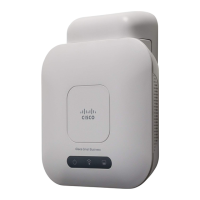SNMP
Views
Cisco WAP571/E Administration Guide 148
10
• Trap Community—A global community string associated with SNMP traps.
Traps sent from the device provide this string as a community name. The
valid range is from 1 to 60 alphanumeric and special characters.
• Trap Destination Table—A list of up to three IP addresses or hostnames to
receive SNMP traps. Check the box and choose a Host IP Address Type
(IPv4 or IPv6) before adding the Hostname/IP Address.
An example of a DNS hostname is snmptraps.foo.com. Because SNMP traps
are sent randomly from the SNMP agent, it makes sense to specify where
exactly the traps should be sent. You can have a maximum of three DNS
hostnames. Ensure that you select the Enabled check box and select the
appropriate Host IP Address Type.
Also see the note about hostnames in the preceding step.
STEP 6 Click Save. The changes are saved to the Startup Configuration.
NOTE After new settings are saved, the corresponding processes may be stopped and
restarted. When this happens, the WAP device may lose connectivity. We
recommend that you change WAP device settings when a loss of connectivity will
least affect your wireless clients.
Views
An SNMP MIB view is a family of view subtrees in the MIB hierarchy. A view
subtree is identified by the pairing of an Object Identifier (OID) subtree value with a
bit string mask value. Each MIB view is defined by two sets of view subtrees,
included in or excluded from the MIB view. You can create MIB views to control the
OID range that SNMPv3 users can access.
The AP supports a maximum of 16 views.
These notes summarize some critical guidelines regarding SNMPv3 view
configuration. Please read all the notes before proceeding.
NOTE A MIB view called all is created by default in the system. This view contains all
management objects supported by the system.
NOTE By default, view-all and view-none SNMPv3 views are created on the WAP device.
These views cannot be deleted or modified.

